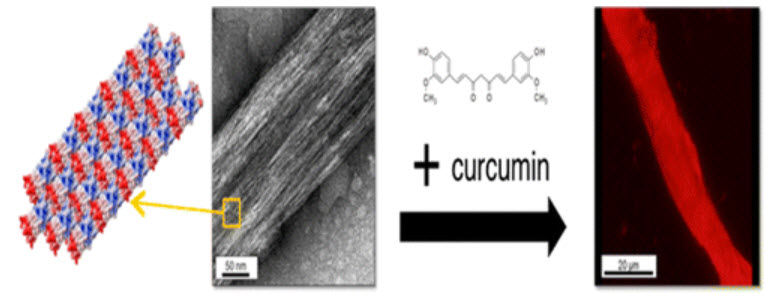An engineered protein microfiber that can also deliver drugs
October 27, 2014

Engineered protein microfibers with cancer drug embedded (credit: Jasmin Hume et al./Biomacromolecules)
Researchers at the New York University Polytechnic School of Engineering have engineered microfiber proteins for the first time, for use in medicine and nanotechnology. Previously, scientists could only create new proteins capable of self-assembling into nanofibers.
Jin Kim Montclare, an associate professor of chemical and biomolecular engineering at the NYU School of Engineering, and her collaborators began their experiments with the intention of designing nanoscale proteins bound with the cancer therapeutic curcumin. They successfully created a novel, self-assembling nanoscale protein, including a hydrophobic pore capable of binding small molecules.
To their surprise, after incubating the fibers with curcumin, the protein not only continued to assemble, but did so to a degree that the fibers crossed the diameter barrier from the nanoscale to the microscale, akin to the diameter of collagen or spider silk.
“This was a surprising and thrilling achievement,” said Montclare, explaining that this kind of diameter increase in the presence of small molecules is unprecedented. “A microscale fiber that is capable of delivering a small molecule, whether it be a therapeutic compound or other material, is a major step forward.”
Biomaterials with small molecules embedded could be used to construct dual-purpose scaffolds for tissue engineering or to deliver certain drugs more efficiently, especially those that are less effective in an aqueous environment.
But the research team believes they can devise even larger fibers. The next step, Montclare says, is developing proteins that can assemble on the milliscale, creating fibers large enough to see with the naked eye. “It’s even possible to imagine generating hair out of cell assembly,” she says.
The research results were published in the journal Biomacromolecules. The work was supported by the Army Research Office and the National Science Foundation.
Abstract of Engineered Coiled-Coil Protein Microfibers
The fabrication of de novo proteins able to self-assemble on the nano- to meso-length scales is critical in the development of protein-based biomaterials in nanotechnology and medicine. Here we report the design and characterization of a protein engineered coiled-coil that not only assembles into microfibers, but also can bind hydrophobic small molecules. Under ambient conditions, the protein forms fibers with nanoscale structure possessing large aspect ratios formed by bundles of α-helical homopentameric assemblies, which further assemble into mesoscale fibers in the presence of curcumin through aggregation. Surprisingly, these biosynthesized fibers are able to form in conditions of remarkably low concentrations. Unlike previously designed coiled-coil fibers, these engineered protein microfibers can bind the small molecule curcumin throughout the assembly, serving as a depot for encapsulation and delivery of other chemical agents within protein-based 3D microenvironments.